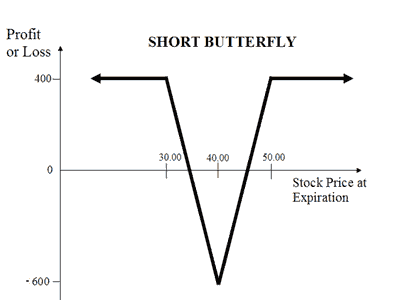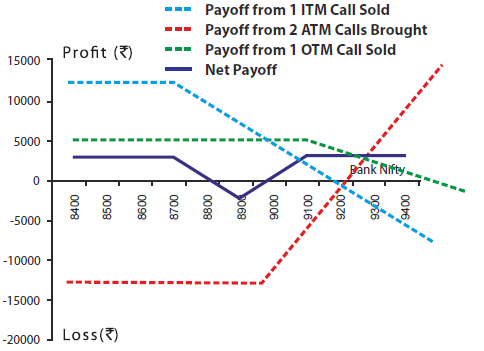 Zerodha (Trading & Demat Account)
Zerodha (Trading & Demat Account)
FREE Equity Delivery and MF
Flat ₹20/trade Intra-day/F&O
 Zerodha (Trading & Demat Account)
Zerodha (Trading & Demat Account)
FREE Equity Delivery and MF
Flat ₹20/trade Intra-day/F&O

|
|
Published on Thursday, April 19, 2018 | Modified on Wednesday, June 5, 2019

| Strategy Level | Advance |
| Instruments Traded | Call |
| Number of Positions | 4 |
| Market View | Neutral |
| Risk Profile | Limited |
| Reward Profile | Limited |
| Breakeven Point | 2 Break-even Points |
Short Call Butterfly (or Short Butterfly) is a neutral strategy similar to Long Butterfly but bullish on the volatility. This strategy is a limited risk and limited profit strategy.
This strategy consists of two long calls at a middle strike (or ATM) and one short call each at a lower and upper strike. All the options must have the same expiration date. Also, the upper and lower strikes (or wings) must both be equidistant from the middle strike (or body).
In simple terms, it involves Sell 1 ITM Call, Buy 2 ATM Calls and Sell 1 OTM Call. The strike prices of all Options should be at equal distance from the current price as shown in the example below.
The usual Short Butterfly strategy looks like as below for NIFTY current index value as 10400 (NIFTY Spot Price):
| Orders | NIFTY Strike Price |
|---|---|
| Sell 1 ITM Call | NIFTY18APR10300CE |
| Buy 2 ATM Call | NIFTY18APR10400CE |
| Sell 1 OTM Call | NIFTY18APR10500CE |
Suppose Nifty is currently trading at 10400. You expect high volatility in it in coming days. You can implement the Short Call Butterfly by buying 2 ATM Nifty Call Options at 10400, sell 1 ITM Call Option at 10300 and other OTM Call Option at 10500. Please ensure that strike prices of Options are at an equal distance (as 100 in above case). Your profit will be limited to the net premium paid on 4 positions while the loss will be limited to strike price of long calls.
This strategy is meant for special scenarios where you foresee a lot of volatility in the market due to election results, budget, policy change, annual result announcements etc.
Example 1 - Stock Options:
Let's take a simple example of a stock trading at Rs 40 (spot price) in June. The option contracts for this stock are available at the premium of:
Lot size: 100 shares in 1 lot
Net Credit: Rs 1100 - Rs 800 + Rs 100 = Rs 400
Now let's discuss the possible scenarios:
Scenario 1: Stock price remains unchanged at Rs 40
In this situation,
The total loss of Rs 600 is also the max loss in this strategy.
Scenario 2: Stock price goes down to Rs 30
In this situation, all the options expire worthlessly. The trader keeps Rs 400 net premium received.
Scenario 3: Stock price goes above Rs 50
In this situation, profits from the two long calls will be neutralized by the loss from the two short calls. The trader keeps Rs 400 net premium received.
In scenario 2 and 3, the trader earns maximum profit which is the initial credit taken to enter the trade. In our example, this is Rs 400 as shown in the chart above.
| Bank Nifty Spot Price | 8900 |
| Bank Nifty Lot Size | 25 |
| Strike Price(Rs ) | Premium(Rs ) | Total Premium Paid(Rs ) (Premium * lot size 25) | |
|---|---|---|---|
| Buy 2 ATM Call | 8900 | 300 * 2 | 15000 |
| Sell 1 ITM Call | 8700 | 500 | 12500 |
| Sell 1 OTM Call | 9100 | 200 | 5000 |
| Net Premium (-600+500+200) | 100 | 2500 | |
| Upper Breakeven(Rs ) | Higher Strike price - Net Premium Paid (9100 - 100) | 9000 |
| Lower Breakeven(Rs ) | Lower Strike price + Net Premium Paid (8700 + 100) | 8800 |
| Maximum Possible Loss (Rs ) | Net Premium Paid | 2500 |
| Maximum Possible Profit (Rs ) | Diff Between Adjacent Strike - Net Premium Debit ((8900-8700)-100)*25 | 2500 |
| On Expiry Bank NIFTY closes at | Net Payoff from 1 ITM Call Sold (Rs ) @8700 | Net Payoff from 2 ATM Call Bought (Rs ) @8900 | Net Payoff from 1 OTM Call Sold (Rs ) @9100 | Net Payoff (Rs ) |
|---|---|---|---|---|
| 8600 | 12500 | -15000 | -5000 | 2500 |
| 8700 | 12500 | -15000 | -5000 | 2500 |
| 8800 | 10000 12500-(8800-8700)*25) | -15000 | -5000 | 0 |
| 8900 | 7500 12500-(8900-8700)*25) | -15000 | -5000 | -2500 |
| 9000 | 5000 12500-(9000-8700)*25) | -10000 (((9000-8900)*25*2)-15000) | -5000 | 0 |
| 9100 | 2500 12500-(9000-8700)*25) | -5000 (((9100-8900)*25*2)-15000) | -5000 | 2500 |
| 9200 | 0 12500-(9000-8700)*25) | 0 (((9200-8900)*25*2)-15000) | -2500 (5000-(9200-9100)*25) | 2500 |

When you are unsure about the direction in the movement in the price of the underlying but are expecting high volatility in it in the near future.
2 Break-even Points
There are 2 break even points in this strategy.
The maximum risk is limited.
Maximum Risk = Higher strike price- Lower Strike Price - Net Premium
The profit is limited to the net premium received. This happens when the price of the underlying is trading beyond the range of strike prices at expiration date.
All Options exercised or not exercised
Only ITM Call exercised
This strategy requires no investment as net premium is positive and received. It allows you to benefit from high volatile market scenarios without the need to speculate on the direction of price movement.
Profitability depends on significant movement in the price of the underlying.
Reverse the trade by selling bought Options and buying back short Options.

Add a public comment...

FREE Intraday Trading (Eq, F&O)
Flat ₹20 Per Trade in F&O
|
|